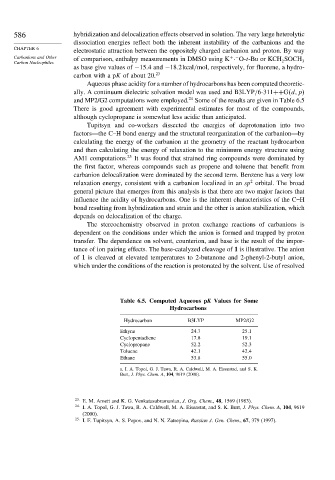Page 604 - Advanced Organic Chemistry Part A - Structure and Mechanisms, 5th ed (2007) - Carey _ Sundberg
P. 604
586 hybridization and delocalization effects observed in solution. The very large heterolytic
dissociation energies reflect both the inherent instability of the carbanions and the
CHAPTER 6
electrostatic attraction between the oppositely charged carbanion and proton. By way
Carbanions and Other of comparison, enthalpy measurements in DMSO using K · O-t-Bu or KCH SOCH
+ −
Carbon Nucleophiles 2 3
as base give values of −15 4 and −18 2kcal/mol, respectively, for fluorene, a hydro-
carbon with a pK of about 20. 23
Aqueous phase acidity for a number of hydrocarbons has been computed theoretic-
ally. A continuum dielectric solvation model was used and B3LYP/6-311++G d p
24
and MP2/G2 computations were employed. Some of the results are given in Table 6.5
There is good agreement with experimental estimates for most of the compounds,
although cyclopropane is somewhat less acidic than anticipated.
Tupitsyn and co-workers dissected the energies of deprotonation into two
factors—the C–H bond energy and the structural reorganization of the carbanion—by
calculating the energy of the carbanion at the geometry of the reactant hydrocarbon
and then calculating the energy of relaxation to the minimum energy structure using
AM1 computations. 25 It was found that strained ring compounds were dominated by
the first factor, whereas compounds such as propene and toluene that benefit from
carbanion delocalization were dominated by the second term. Benzene has a very low
2
relaxation energy, consistent with a carbanion localized in an sp orbital. The broad
general picture that emerges from this analysis is that there are two major factors that
influence the acidity of hydrocarbons. One is the inherent characteristics of the C–H
bond resulting from hybridization and strain and the other is anion stabilization, which
depends on delocalization of the charge.
The stereochemistry observed in proton exchange reactions of carbanions is
dependent on the conditions under which the anion is formed and trapped by proton
transfer. The dependence on solvent, counterion, and base is the result of the impor-
tance of ion pairing effects. The base-catalyzed cleavage of 1 is illustrative. The anion
of 1 is cleaved at elevated temperatures to 2-butanone and 2-phenyl-2-butyl anion,
which under the conditions of the reaction is protonated by the solvent. Use of resolved
Table 6.5. Computed Aqueous pK Values for Some
Hydrocarbons
Hydrocarbon B3LYP MP2/G2
Ethyne 24 7 25 1
Cyclopentadiene 17 8 19 1
Cyclopropane 52 2 52 3
Toluene 42 1 42 4
Ethane 53 8 55 0
a. I. A. Topol, G. J. Tawa, R. A. Caldwell, M. A. Eisenstad, and S. K.
Burt, J. Phys. Chem. A, 104, 9619 (2000).
23 E. M. Arnett and K. G. Venkatasubramanian, J. Org. Chem., 48, 1569 (1983).
24 I. A. Topol, G. J. Tawa, R. A. Caldwell, M. A. Eisenstat, and S. K. Burt, J. Phys. Chem. A, 104, 9619
(2000).
25
I. F. Tupitsyn, A. S. Popov, and N. N. Zatsepina, Russian J. Gen. Chem., 67, 379 (1997).

